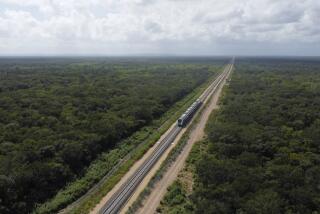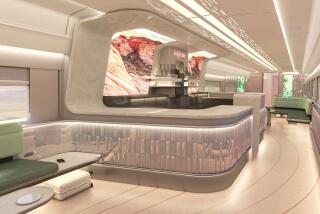Amtrak Plans to Hasten the New York Minute : Transportation: On the Colorado prairie, engineers are testing trains that will link Eastern Corridor cities at speeds up to 150 mph.
- Share via
PUEBLO, Colo. — Even at a standstill, the silver, bullet-nosed train looks out of place on this remote, brush-covered prairie, where the horizon is broken only by the far-off silhouette of Pikes Peak and an occasional antelope.
And when it moves, under the close watch of a group of engineers, it becomes a gray streak flashing through the landscape of sagebrush and sunflowers.
Eventually it will go 150 mph, making it the fastest train in the country. And that’s not even its top speed.
“We had it up to 167 mph a couple weeks ago,” Ernie Chance, Amtrak’s assistant chief mechanic officer, said from inside the engineer’s quarters. “And it felt like she still had more power in her.”
“She” is one of 20 high-speed electric trains named Acelas that Amtrak is having built as part of a $2-billion project. The Acelas, unveiled in March, will be used along routes connecting Boston, New York and Washington, with the first passenger runs scheduled for November or December.
One of the new trains is being tested for up to 16 hours a day on a 13-mile track at the Transportation Technology Center, which sprawls across 52 square miles of land about 25 miles northeast of Pueblo. The center is a subsidiary of the Assn. of American Railroads, representing North American freight railroads and Amtrak.
“It’s remote, and we can do a lot of testing with relative secrecy,” said Keith Hawthorne, the center’s vice president of technology. “Our customers like that; they want to be able to iron out their problems in private.”
The Acelas are designed to tilt gently as the trains rush around curves. That doesn’t promote speed as much as it prevents centrifugal force from throwing the passengers around.
But even with the tilt mechanism deactivated for a test run at a mere 110 mph, the ride on the special test track is much smoother and freer of vibration than Amtrak’s existing Metroliner service in the Northeast Corridor.
There’s no need to grab the seats for balance while walking down the train’s aisle. Filling in a New York Times crossword puzzle is easy--if you know the answers--and the quiet ride makes conversation easy too.
“The bistro car will have stand-up tables with pedestal seating like a bar,” said Chance. “With this ride, especially with the tilt system on, it should be as comfortable for people to stand up as it is to sit.”
Two cars of the train that is being tested have been transformed into traveling laboratories, filled with computers, printers and miles of cable. A dozen engineers perform tests on the train’s propulsion, endurance, acceleration, energy consumption, wheel wear and ride quality.
“Every day we have a problem that we fix the next day,” said Gilles Losier, the supervisor of quality assurance and testing for Bombardier Inc., the train’s Montreal-based manufacturer.
The most difficult problem encountered so far occurred when the wheel sets began shaking from side to side at speeds of 130 mph to 145 mph. The wheels, a French design, were reshaped to fit more closely with the American-made track.
Initially, old tracks on the Washington-New York line will limit the Acelas to 135 mph, Chance said. That is 10 mph faster than the Metroliners run now, and will slice 16 minutes off the trip.
After the tracks are reconfigured, the trains will be able to run at 150 mph, cutting an additional 13 minutes off the trip, said John Wolf, an Amtrak spokesman.
The New York-Boston leg will require new overhead electrical wires in addition to track improvements. Wolf says Amtrak hopes to trim that trip from 4 1/2 hours to three.
More to Read
Sign up for Essential California
The most important California stories and recommendations in your inbox every morning.
You may occasionally receive promotional content from the Los Angeles Times.










